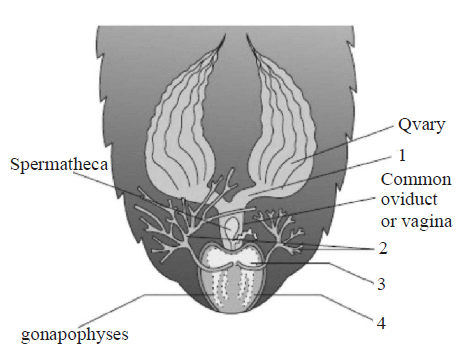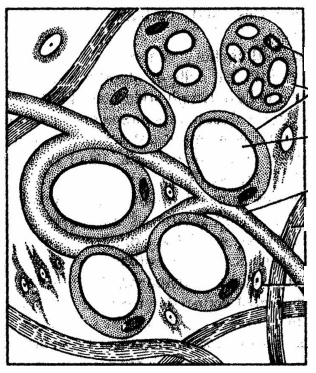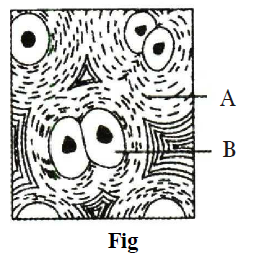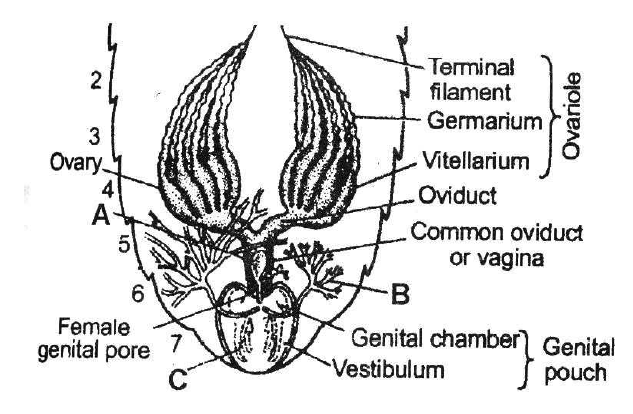Which of the following statement(s) is/are correct regarding excretory system of cockroach ?
- Excretion is performed by malphigian tubules.
- They absorb nitrogenous waste products and convert them into uric acid which is excreted out through hindgut. Hence, this insect called ammonetelic.
- In addition, fat body, nephrocytes and uricose glands also help in excretion.
Only (i)
Both (ii) and (iii)
Both (i) and (iii)
All of these
Correct Answer :
C. Both (i) and (iii)
Cockroaches absorb nitrogenous waste products and convert them into uric acid which is excreted out-through hindgut. Hence they called as uricotelic.
Related Questions
Intercalated discs are the communication junctions between the cells of
cardiac muscles
striped muscles
adipose tissue
nerve and striated muscles
The kind of epithelium which forms the inner walls of blood vessels is
cuboidal epithelium
columnar epithelium
ciliated columnar epithelium
squamous epithelium
Cartilage tissues are likely to be slow in healing following an injury because
cartilage cells cannot reproduce.
they lack direct blood supplies.
the intercellular material is missing.
cartilage cells are surrounded by fluids.
Compound squamous epithelium is found in
stomach
intestine
trachea
pharynx
The frog never drinks water but absorbs it through one of its respiratory organ. Identify the organ.
Skin
Lung
Buccal cavity
None of the above.
Non-ciliated simple columnar epithelium often contains _______, which increase the surface area for secretion and absorption.
flagella
collagen fibres
microvilli
all of these
Match column-I (type of epithelium) with column-II (Description) and choose the correct option.
| Column-I | Column-II |
|---|---|
| (Types of epithelium) | (Description) |
| A. Squamous | I. It is composed of a epithelium single-layer of cube-like cells |
| B. Cuboidal | II. Having cilia on their free epithelium surface |
| C. Columnar | III. It is composed of a single epithelium layer of tall and slender cells |
| D. Ciliated | IV. It is made up of a single thin epithelium layer of flattened cells with irregular boundaries |
A IV; B I; C III; D II
A I; B IV; C III; D II
A IV; B I; C II; D III
A IV; B III; C I; D II
Match column-I with column-II and choose the correct option.
| Column-I | Column-II |
|---|---|
| A. Periplaneta | I. Hepatic caecae americana |
| B. A ring of 6-8 blind | II. Phylum arthropoda tubules |
| C. Vascular system | III. Spiracles |
| D. 10 pairs of small | IV. Malpighian tubules holes |
| E. Excretion | V. Open type |
A I; B II; C III; D IV; E V
A II; B I; C V; D III; E IV
A II; B I; C III; D V; E IV
A III; B IV; C II; D V; E I
Which of the following statement(s) is/are correct about muscle tissue ?
Each muscle is made of many long, cylindrical fibres arranged in parallel arrays.
Muscle fibres contract (shorten) in response to stimulation, then relax (lengthen) and return to their uncontracted state in a coordinated fashion.
Muscles play an active role in all movements of the body.
All of the above
Refer the given figure of female reproductive system of cockroach and identify the correct labels (marked as 1, 2, 3 and 4) which are collectively called genital pouch.

1 & 2
1 & 3
2 & 4
3 & 4
Identify the figure with its correct function Fig :. Adipose connective tissue

Areolar connective tissue Serves as a support framework for epithelium.
Adipose tissue Store fats and act as heat insulators.
Dense regular tissue Provide flexibility.
Dense irregular tissue Provide strength and elasticity.
The given figure shows the digestive system of cockroach with few structures marked as A, B, C and D. Identify structures A to D.

A-Gizzard, B-Crop, C-Hepatic caecae, D-Malpighian tubules
A-Crop, B-Gizzard, C-Hepatic caecae, D-Malpighian tubules
A- Crop, B-Gizzard, C-Malpighian tubules, D-Hepatic caecae
A- Gizzard, B-Crop, C-Malpighian tubules, D-Hepatic caecae
The intercellular material of the given figure is solid and resists compression. Identify the figure and the label marked as A & B.

Fig - Cartilage, A - Collagen, B - Collagen
Fig - Cartilage, A - Microtubule, B - Collagen fibres
Fig - Bone, A - Chondrocyte, B - Chondroclast
Fig - Bone, A - Chondroclast, B - Osteoblast
Match the description given in column I with their examples given in column II and choose the correct option.
| Column I | Column II |
|---|---|
| (Description) | (Example) |
| 1. Aquatic respiratory | A. Skin organ |
| 2. Organ which acts | B. Ureter urogenital duct and opens into the cloaca |
| 3. A small median chamber | C. Cloaca that is used to pass faecal matter, urine and sperms to the exterior |
| 4. A triangular structure | D. Sinus venosus which joins the right atrium and receives blood through vena cava |
1 - A, 2 - B, 3 - C, 4 - D
1 - C, 2 - A, 3 - D, 4 - B
1 - B, 2 - A, 3 - C, 4 - D
1 - C, 2 - B, 3 - D, 4 - A
Figure given below shows reproductive system of female cockroach. The correct labellings indicated by alphabets (A, B & C) are respectively

A-Spermatheca, B-Collaterial glands, C-Gonapophyses
A-Phallic gland, B-Collaterial glands, C-Gonapophyses
A-Spermatheca, B-Seminal vesicle, C-Gonapophyses
A-Spermatheca, B-Collateral glands, C-Tegmina
Tendons and ligaments are the examples of
areolar connective tissue
adipose tissue
dense regular connective tissue
loose connective tissue
Read the following statements and answer the question.
- It is made of a single thin layer of flattened cells with irregular boundaries.
- They are found in the walls of blood vessels and air sacs of lungs.
- They are involved in functions like forming a diffusion boundary.
Which of the following characteristics of tissue is being described by the above statements ?
Squamous epithelium
Columnar epithelium
Ciliated epithelium
Compound epithelium
Hair present in the skin are
epidermal in origin and made of dead cells.
epidermal in origin and made of living cells.
dermal in origin and made of living cells.
dermal in origin and made of dead cells.
Which of the following is involved in the production of new blood cells ?
Adipose cell
Bone marrow
Liver
Matrix
The only type of cell seen in a tendon is
muscle fibres
reticular cells
collagenous cells
fibroblasts
Which of the following type of tissue is being described by the given statements ?
- They are named because of their special function of linking and supporting other tissues/organs of the body.
- They include cartilage, bone, adipose and blood.
- They provide strength, elasticity and flexibility to the tissue.
- They also secrete modified polysaccharides, which accumulate between cells and fibres and act as matrix.
Epithelial tissue
Connective tissue
Muscle tissue
Neural tissue
Muscle tissue cells are contractile, which means they
are responsible for the production and secretion of enzymes.
are specialized in contraction and relaxation.
help in the movement of involuntary organs only.
all of the above
The shape of a persons ear is due to mainly to
dense regular connective tissue
dense irregular connective tissue
elastic cartilage
fibrocartilage
Which of the following statement(s) is/are correct regarding excretory system of cockroach ?
- Excretion is performed by malphigian tubules.
- They absorb nitrogenous waste products and convert them into uric acid which is excreted out through hindgut. Hence, this insect called ammonetelic.
- In addition, fat body, nephrocytes and uricose glands also help in excretion.
Only (i)
Both (ii) and (iii)
Both (i) and (iii)
All of these
The blood of cockroach contains no respiratory pigment. It means that
cockroach does not respire.
respiration is anaerobic.
oxygen goes directly into tissues by diffusion.
oxygen goes directly into tissues by intracellular capillary system.
The given figure shows open circulatory system of cockroach with structure marked as A, B and C. Which structure is a 13 pair of wing shaped involuntary muscles and mantain blood circulation?

A
B
C
Both A nad B
If the head of cockroach is cut off, it will still alive for as long as one week. It is because of
the body which is covered with a hard chitinous exoskeleton.
head which holds a bit of nervous system.
head which is of no use.
food capturing appratus which is found elsewhere.
The supportive skeletal structures in the human external ears and in the nose tip are examples of
ligament
areolar tissue
bone
cartilage
In the given diagram of areolar connective tissue, the different cells and parts have been marked by alphabets (A, B, C & D). Choose the answer in which these alphabets correctly match with the parts and cells they indicate.

A-Adipocyte, B-Collagen fibres, C-Microfilament, D-Mast cells
A-Macrophage, B-Collagen fibres, C-Microfilament, D-Mast cells
A-Macrophage, B-Collagen fibres, C-Microtubule, D-RBC
A-Macrophage, B-Fibroblast, C-Collagen fibres, D-Mast cells
Find the incorrectly matched pair.
Unicellular glandular cells - Goblet cell
Saliva - Exocrine secretion
Fusiform fibres - Smooth muscle
Cartilage - Areolar tissue
